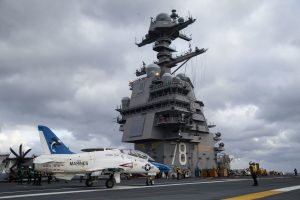The USS Gerald R. Ford (CVN-78) passed Aircraft Compatibility Testing (ACT) on January 31, following 16 days at sea, during which the carrier launched and recovered 211 aircraft, the U.S. Navy said in a February 5 statement.
Using the carrier’s unique Electromagnetic Aircraft Launch System (EMALS) and Advanced Arresting Gear (AAG), the ACT entailed catapult launches and arrested landings of five aircraft including the T-45 Goshawk and E/A-18G Growler, the E-2D Advanced Hawkeye and C-2A Greyhound.
“During ACT, test pilots from Air Test and Evaluation Squadron (VX) 20 and VX-23 conducted catapult launches and arrested landings in order to verify EMALS and AAG performance mandates,” according to the Navy.
The ACT began on January 16 and concluded with 211 successful launches and arrestments using EMALS and AAG technology at the end of last month.
“The Gerald R. Ford now has 958 total traps to date and will likely surpass 1,000 launches and arrestments during the upcoming Flight Deck Certification (FDC) phase, currently scheduled for March, when her crew and Carrier Air Wing (CVW) Eight will take over all aspects of flight operations,” the statement reads.
The USS Gerald R. Ford completed its post-shakedown availability (PSA) period at Newport News Shipbuilding in Newport News, Virginia in October 2019. The Navy originally planned a one year PSA, but extended it by 3 months, principally due to the additional work required on the carrier’s Advanced Weapons Elevators (AWEs). The PSA also included additional work on the AAG.
“The CVN 78 PSA began on July 15, 2018, and included work on Advanced Weapons Elevators (AWEs), repairs to the ship’s main reduction gear, improvements to the throttle control system, upgrades to the Advanced Arresting Gear, and numerous other maintenance tasks,” the Navy said in a October 2019 statement.
Overall, the Ford-class incorporates 23 new technologies, which have caused repeated delays. The carrier was originally slated to deploy in 2018. A new tentative date has been now set for 2022.
A recent U.S. government report revealed deficiencies and limitations of three of the carrier’s combat systems: the SLQ‑32(V)6 electronic warfare system, the SPY-3 Multi‑Function Radar (MFR), and the Cooperative Engagement Capability (CEC).
“These deficiencies and limitations reduce the overall self-defense capability of the ship,” the Office of the Director of Operational Test and Evaluation (DOT&E) reported.
The report also notes that the carrier “is unlikely to achieve the Sortie Generation Rate (SGR) (number of aircraft sorties per day) requirement.”
The USS Gerald R. Ford was designed to increase the SGR by 25 to 30 percent over the previous Nimitz-class of nuclear aircraft carriers.
“Unrealistic assumptions underpin the SGR threshold requirement,” according to the report. ‘These assumptions ignore the effects of weather, aircraft emergencies, ship maneuvers, and current Air Wing composition on flight operations.”

































